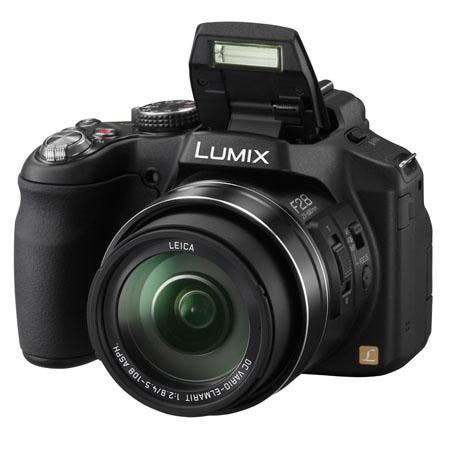The Panasonic Lumix FZ1000 can be pre-ordered now from Adorama. Orders will be shipped on a first-come, first-served basis. Credit cards will not be charged until orders are shipped.
Panasonic today announced thePanasonic Lumix FZ1000, a 20.1MP all-in-one extended-zoom camera with a 1-inch CMOS image sensor. The big news is that it’s the first compact digital camera to boast 4K video support. The FZ100 features a 16x built-in zoom lens, 12fps burst rate, a flip-out LCD monitor, and an eye-level electronic viewfinder. The camera is expected to appeal to serious videographers, advanced amateur photographers, and first adopters of new technology.
Panasonic Lumix FZ1000 Key Features
- 20MP 1-inch (13.2×8.8mm) CMOS sensor
- ISO 125-12800, expandable to 80-25,600
- Macro focus to 3cm
- In-Camera RAW processing
- 25-400mm (35mm equivalent) f/2.8-4 built-in zoom lens
- Viewfinder resolution: 2.359k pixels
- LCD: 3 inch touchscreen, 921k, flip-out design
- Shutter speeds 60-1/6000 sec
- 12fps burst rate
- Exposure compensation +/-5EV in 1/3 stop increments
- 4k, full HD video available
- CIPA battery life: 360 shots
- Weight: 1.83 lbs
- Dimensions: 5.39×3.9×5.16 inches
Panasonic Lumix FZ1000 In Depth
With a metal/composite body similar in size and weight to a typical consumer DSLR, the FZ1000’s sensor offers an ISO range from 125-12,800, boostable to 25,600. The camera is capable of capturing both 4K and 8MP still images simultaneously when shooting in video, and full 20.1MP images when just shooting stills.
The built-in lens is a Leica DC Vario-Elmarit 9.1-146mm f/2.8-4, covering the equivalent of a 25-400mm range on a 35mm format lens. The lens, which is the fruit of a long-term technological partnership between Panasonic and Leica, can focus as close as 3cm (approx 1.5 inches) from the surface of the lens. Panasonic claims that focus speed is 275 percent faster than the conventional Panasonic FZ200, thanks to a newly-designed linear motor that is integrated into its focus system.
Panasonic also boasts a new focus technology, DFD (Depth From Defocus) technology. This technology instantly calculates the distance to the subject by evaluating two images with different sharpness levels. This is said to reduce AF acquisition time to 0.09 seconds at the widest setting and 0.17 seconds at the telephoto setting, which would be a big improvement over other EVF zoom systems.
In addition to DFD, the high-end Leica lens is backed up by multiple focus options, from 49-area AF to pinpoint AF, which focuses on a tiny, magnified area. Full-area AF allows the user to set focus on any area of the scene, while low-light AF boosts the gain to get AF performance even in extremely low light such as -4EV. There is also focus peaking, which is advantageous when focusing manually, and eye detection AF.
The Panasonic FZ1000 also employs Hybrid IOS (Optical Image Stabilizer) with five-axis correction for camera motion blur. This reduces motion blure due to horizontal, vertical, axis of rotation, vertical rotation and horizontal rotation. Another feature we haven’t seen before is the Level Shot Function, which detects the image’s horizontal line and maintains it even if the camera is tilted. These features are great for steady video, but only work when shooting HD videos, not 4K.
4k video is captured at up to 30fps in MP4 format as well as at 1080p at 30 and 60fps. Other video features include full HD video at 120fps, time-lapse and stop-motion animation, as well as a variety of video effects.
The 0.39-inch electronic viewfinder is one of the highest resolution EVFs on the market with 2.359k dots. The 3-inch flip-out LCD has a 921k dot resolution, rotates 180 degrees to either side and tilts 270 degrees up and down. The DMC-FZ1000 includes 22 filters, including HDR, Soft Focus, Miniature Effect, and Sepia.
 Finally, the Panasonic FZ1000 integrates Wi-Fi connectivity with NFC (Near Field Communication) for use in wireless hot spots and in tandem with tablets and smart phones. With the Panasonic “Image App”, remote shooting of both stills and video is possible by using the smartphone/tablet for a remote shutter with a monitor. Users can release the shutter, zoom, focus and set shutter speed, aperture, exposure compensation with a smartphone / tablet. Panasonic recommends using UHS Speed Class 3 (U3) SD cards with a minimum write speed of 30MB/s, such as this new one that was just introduced by Panasonic, to accommodate the resource-demanding needs of 4K video.
Finally, the Panasonic FZ1000 integrates Wi-Fi connectivity with NFC (Near Field Communication) for use in wireless hot spots and in tandem with tablets and smart phones. With the Panasonic “Image App”, remote shooting of both stills and video is possible by using the smartphone/tablet for a remote shutter with a monitor. Users can release the shutter, zoom, focus and set shutter speed, aperture, exposure compensation with a smartphone / tablet. Panasonic recommends using UHS Speed Class 3 (U3) SD cards with a minimum write speed of 30MB/s, such as this new one that was just introduced by Panasonic, to accommodate the resource-demanding needs of 4K video.
Casing the Competition
The Panasonic Lumix FZ1000‘s specs invite comparison with the Sony DXC-RX10 since both feature the same size sensor with identical resolution. The differences: The FZ1000 has a longer zoom range but not constant aperture (the RX10 is a constant f/2.8), and can capture 4K video instead of the RX10’s 1080p HD. At an Adorama price of $879.99, the Panasonic DMC-FZ1000 is less expensive than the $1,298 Sony RX10.
The Panasonic Lumix FZ1000 will be available for $879.99 in July but it can be pre-ordered now from Adorama.



